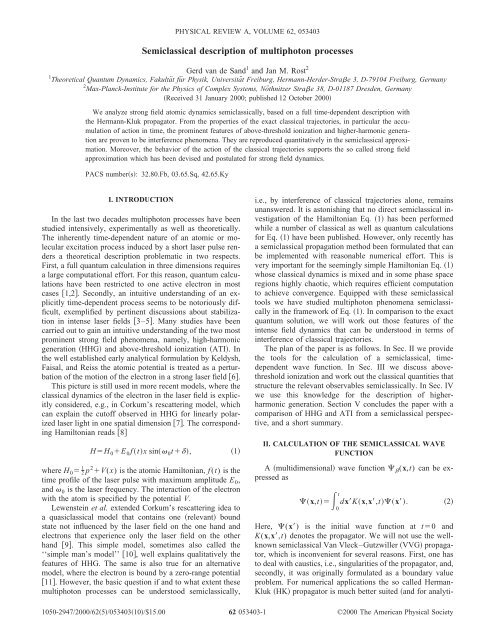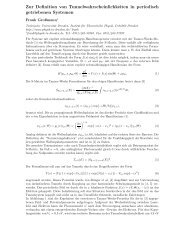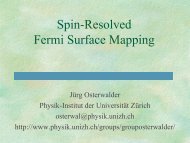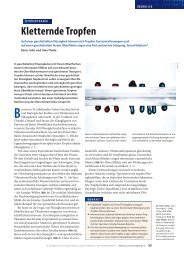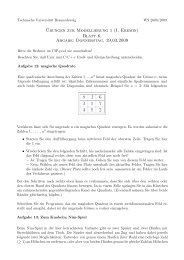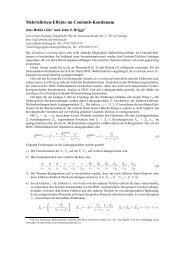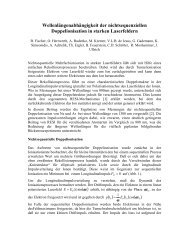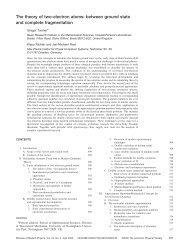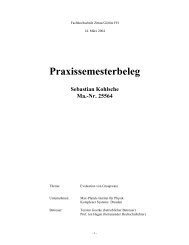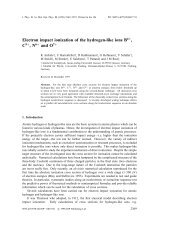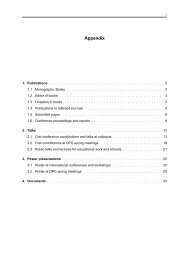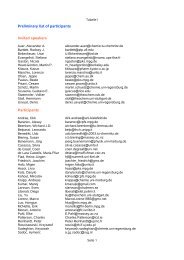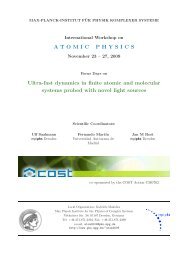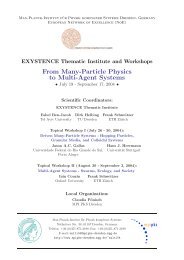Semiclassical description of multiphoton processes - Max-Planck ...
Semiclassical description of multiphoton processes - Max-Planck ...
Semiclassical description of multiphoton processes - Max-Planck ...
Create successful ePaper yourself
Turn your PDF publications into a flip-book with our unique Google optimized e-Paper software.
<strong>Semiclassical</strong> <strong>description</strong> <strong>of</strong> <strong>multiphoton</strong> <strong>processes</strong><br />
Gerd van de Sand 1 and Jan M. Rost 2<br />
1 Theoretical Quantum Dynamics, Fakultät für Physik, Universität Freiburg, Hermann-Herder-Strae 3, D-79104 Freiburg, Germany<br />
2 <strong>Max</strong>-<strong>Planck</strong>-Institute for the Physics <strong>of</strong> Complex Systems, Nöthnitzer Strae 38, D-01187 Dresden, Germany<br />
Received 31 January 2000; published 12 October 2000<br />
We analyze strong field atomic dynamics semiclassically, based on a full time-dependent <strong>description</strong> with<br />
the Hermann-Kluk propagator. From the properties <strong>of</strong> the exact classical trajectories, in particular the accumulation<br />
<strong>of</strong> action in time, the prominent features <strong>of</strong> above-threshold ionization and higher-harmonic generation<br />
are proven to be interference phenomena. They are reproduced quantitatively in the semiclassical approximation.<br />
Moreover, the behavior <strong>of</strong> the action <strong>of</strong> the classical trajectories supports the so called strong field<br />
approximation which has been devised and postulated for strong field dynamics.<br />
PACS numbers: 32.80.Fb, 03.65.Sq, 42.65.Ky<br />
I. INTRODUCTION<br />
In the last two decades <strong>multiphoton</strong> <strong>processes</strong> have been<br />
studied intensively, experimentally as well as theoretically.<br />
The inherently time-dependent nature <strong>of</strong> an atomic or molecular<br />
excitation process induced by a short laser pulse renders<br />
a theoretical <strong>description</strong> problematic in two respects.<br />
First, a full quantum calculation in three dimensions requires<br />
a large computational effort. For this reason, quantum calculations<br />
have been restricted to one active electron in most<br />
cases 1,2. Secondly, an intuitive understanding <strong>of</strong> an explicitly<br />
time-dependent process seems to be notoriously difficult,<br />
exemplified by pertinent discussions about stabilization<br />
in intense laser fields 3–5. Many studies have been<br />
carried out to gain an intuitive understanding <strong>of</strong> the two most<br />
prominent strong field phenomena, namely, high-harmonic<br />
generation HHG and above-threshold ionization ATI. In<br />
the well established early analytical formulation by Keldysh,<br />
Faisal, and Reiss the atomic potential is treated as a perturbation<br />
<strong>of</strong> the motion <strong>of</strong> the electron in a strong laser field 6.<br />
This picture is still used in more recent models, where the<br />
classical dynamics <strong>of</strong> the electron in the laser field is explicitly<br />
considered, e.g., in Corkum’s rescattering model, which<br />
can explain the cut<strong>of</strong>f observed in HHG for linearly polarized<br />
laser light in one spatial dimension 7. The corresponding<br />
Hamiltonian reads 8<br />
HH 0E 0f tx sin 0t, 1<br />
where H 0 1<br />
2 p 2 V(x) is the atomic Hamiltonian, f (t) is the<br />
time pr<strong>of</strong>ile <strong>of</strong> the laser pulse with maximum amplitude E 0,<br />
and 0 is the laser frequency. The interaction <strong>of</strong> the electron<br />
with the atom is specified by the potential V.<br />
Lewenstein et al. extended Corkum’s rescattering idea to<br />
a quasiclassical model that contains one relevant bound<br />
state not influenced by the laser field on the one hand and<br />
electrons that experience only the laser field on the other<br />
hand 9. This simple model, sometimes also called the<br />
‘‘simple man’s model’’ 10, well explains qualitatively the<br />
features <strong>of</strong> HHG. The same is also true for an alternative<br />
model, where the electron is bound by a zero-range potential<br />
11. However, the basic question if and to what extent these<br />
<strong>multiphoton</strong> <strong>processes</strong> can be understood semiclassically,<br />
PHYSICAL REVIEW A, VOLUME 62, 053403<br />
i.e., by interference <strong>of</strong> classical trajectories alone, remains<br />
unanswered. It is astonishing that no direct semiclassical investigation<br />
<strong>of</strong> the Hamiltonian Eq. 1 has been performed<br />
while a number <strong>of</strong> classical as well as quantum calculations<br />
for Eq. 1 have been published. However, only recently has<br />
a semiclassical propagation method been formulated that can<br />
be implemented with reasonable numerical effort. This is<br />
very important for the seemingly simple Hamiltonian Eq. 1<br />
whose classical dynamics is mixed and in some phase space<br />
regions highly chaotic, which requires efficient computation<br />
to achieve convergence. Equipped with these semiclassical<br />
tools we have studied <strong>multiphoton</strong> phenomena semiclassically<br />
in the framework <strong>of</strong> Eq. 1. In comparison to the exact<br />
quantum solution, we will work out those features <strong>of</strong> the<br />
intense field dynamics that can be understood in terms <strong>of</strong><br />
interference <strong>of</strong> classical trajectories.<br />
The plan <strong>of</strong> the paper is as follows. In Sec. II we provide<br />
the tools for the calculation <strong>of</strong> a semiclassical, timedependent<br />
wave function. In Sec. III we discuss abovethreshold<br />
ionization and work out the classical quantities that<br />
structure the relevant observables semiclassically. In Sec. IV<br />
we use this knowledge for the <strong>description</strong> <strong>of</strong> higherharmonic<br />
generation. Section V concludes the paper with a<br />
comparison <strong>of</strong> HHG and ATI from a semiclassical perspective,<br />
and a short summary.<br />
II. CALCULATION OF THE SEMICLASSICAL WAVE<br />
FUNCTION<br />
A multidimensional wave function (x,t) can be expressed<br />
as<br />
t<br />
x,t<br />
0<br />
dxKx,x,tx. 2<br />
Here, (x) is the initial wave function at t0 and<br />
K(x,x,t) denotes the propagator. We will not use the wellknown<br />
semiclassical Van Vleck–Gutzwiller VVG propagator,<br />
which is inconvenient for several reasons. First, one has<br />
to deal with caustics, i.e., singularities <strong>of</strong> the propagator, and,<br />
secondly, it was originally formulated as a boundary value<br />
problem. For numerical applications the so called Herman-<br />
Kluk HK propagator is much better suited and for analyti-<br />
1050-2947/2000/625/05340310/$15.00 62 053403-1<br />
©2000 The American Physical Society
GERD van de SAND AND JAN M. ROST PHYSICAL REVIEW A 62 053403<br />
cal considerations not worse; this is a uniformized propagator<br />
in initial value representation 12,13, which reads in a<br />
2n-dimensional phase space<br />
with<br />
and<br />
K HK x,x,t<br />
1<br />
2 ndpdqC qpte iS qp (t)/<br />
g x;qt,ptg *x;q,p 3<br />
gx;q,p n/4<br />
exp <br />
2 xq2 i<br />
pxq 4<br />
C qpt 1<br />
2 Q qP piQ p 1<br />
i P q 1/2<br />
. 5<br />
Each phase space point (q,p) in the integrand <strong>of</strong> Eq. 3 is<br />
the starting point <strong>of</strong> a classical trajectory with action S qp(t).<br />
The terms X y in the weight factor C qp(t) are the four elements<br />
<strong>of</strong> the monodromy matrix, X yx t /y. The square<br />
root in Eq. 5 has to be calculated in such a manner that<br />
C qp(t) is a continuous function <strong>of</strong> t. The integrand in Eq. 3<br />
is—depending on the system—highly oscillatory. Although<br />
the formulation presented is in the full dimensional space<br />
and there are no major obstacles to carrying out the calculation,<br />
we have restricted ourselves for this explorative study<br />
to one spatial dimension see Eq. 1 since the numerical<br />
effort is considerable for the one-dimensional case the number<br />
<strong>of</strong> trajectories necessary for numerical convergence can<br />
already reach 10 7 . We note in passing that an integration by<br />
the stationary phase approximation over momentum and coordinate<br />
variables reduces the HK propagator to the VVG<br />
propagator 14.<br />
In all calculations presented here we have used a Gaussian<br />
wave packet as initial wave function,<br />
x <br />
1/4<br />
<br />
With this choice, the overlap<br />
exp <br />
2 xq 2 . 6<br />
f q,p g *x;q,p xdx 7<br />
can be calculated analytically and Eq. 2 reads, together<br />
with Eq. 3,<br />
HK x,t 4<br />
2 1/4<br />
1 <br />
2dpdqe iS qp (t)/ C qpt<br />
g „x;qt,pt…f q,p 8<br />
with . For all results presented here we have taken<br />
.<br />
For comparison with our semiclassical calculations we<br />
determined the quantum-mechanical wave function using<br />
standard fast-Fourier-transform split-operator methods 15.<br />
053403-2<br />
FIG. 1. Quantum-mechanical dotted line and semiclassical<br />
solid line ATI spectra for the Hamiltonian <strong>of</strong> Eq. 1 with E 0<br />
0.15 a.u., 00.148 a.u., and the s<strong>of</strong>t-core potential Eq. 11.<br />
III. ABOVE-THRESHOLD IONIZATION<br />
We start from Eq. 1 with 0 and use a rectangular<br />
pulse shape f (t) which lasts for 4.25 optical cycles. This<br />
setting is very similar to the one used in 16.<br />
The energy spectrum <strong>of</strong> the electrons can be expressed by<br />
the Fourier transform <strong>of</strong> the autocorrelation function after the<br />
pulse, i.e., for times tt f ,<br />
Re t f<br />
<br />
e it t fdt, 9<br />
where f(t f) is the wave function after the pulse and<br />
correspondingly<br />
te iH 0 (tt f )/ f 10<br />
is calculated by propagating f for some time with the<br />
atomic Hamiltonian H 0 only after the laser has been<br />
switched <strong>of</strong>f.<br />
A. Quantum-mechanical and semiclassical spectra for ATI<br />
We will present results for two types <strong>of</strong> potential to elucidate<br />
the dependence <strong>of</strong> the semiclassical approximation on<br />
the form <strong>of</strong> the potential.<br />
1. S<strong>of</strong>t-core potential<br />
First we apply the widely used s<strong>of</strong>tcore potential 16,17<br />
Vx 1<br />
x 2 a<br />
11<br />
with a1 and with an ionization potential I p0.670 a.u. We<br />
have checked that the correlation function differs little if calculated<br />
with the exact ground state or with the ground state<br />
wave function approximated by the Gaussian <strong>of</strong> Eq. 6<br />
where 0.431 a.u. and q 0. However, the semiclassical<br />
calculation is considerably simplified with a Gaussian as initial<br />
state as can be seen from Eqs. 6–8. Therefore we use<br />
this initial state and obtain the propagated semiclassical<br />
wave function in the closed form, Eq. 8. In Fig. 1 the quantum<br />
and semiclassical results at a frequency 00.148 a.u.
SEMICLASSICAL DESCRIPTION OF MULTIPHOTON . . . PHYSICAL REVIEW A 62 053403<br />
and a field strength E 00.15 a.u. are compared. The<br />
quantum-mechanical calculation dotted line shows a typical<br />
ATI spectrum. Intensity maxima with a separation in energy<br />
<strong>of</strong> 0 are clearly visible. The first maximum has the<br />
highest intensity while the second maximum is suppressed.<br />
The semiclassical result solid line is ambiguous: On the<br />
one hand there are clear ATI maxima with a separation <strong>of</strong><br />
0. All peaks but the first one have roughly the correct<br />
magnitude. Again the second maximum is missing. On the<br />
other hand we see a constant shift about 0.02 a.u. <strong>of</strong> the<br />
spectrum toward higher energies. Therefore, a quantitative<br />
semiclassical <strong>description</strong> is impossible, at least with the<br />
present parameters and the s<strong>of</strong>t-core potential. As it has<br />
turned out, in the time interval before ionization the bound<br />
electron wave packet evolves quite differently in the s<strong>of</strong>tcore<br />
potential under quantum and semiclassical propagation.<br />
We will demonstrate that indeed the bound state dynamics is<br />
primarily responsible for the shift in the spectrum. This will<br />
be done by considering a different potential, which behaves<br />
almost harmonically for the lower bound states, implying a<br />
similar evolution <strong>of</strong> the wave packet under quantum and<br />
semiclassical propagation and thus eliminating this source <strong>of</strong><br />
error.<br />
2. Gaussian potential<br />
A potential suitable for our purpose has been used to<br />
model the ‘‘single bound state’’ situation mentioned in the<br />
Introduction 18. It is <strong>of</strong> Gaussian form,<br />
VxV 0 expx 2 . 12<br />
With our choice <strong>of</strong> parameters V 00.6 a.u. and 0.025<br />
a.u., the potential contains six bound states and can be approximated,<br />
at least in the lower-energy part, by a harmonic<br />
potential for which semiclassical calculations are exact.<br />
Hence, the semiclassical ATI spectrum with this potential<br />
should be more accurate if the discrepancies in Fig. 1 are due<br />
to the potential and not to the laser interaction. The ground<br />
state wave function itself is again well approximated by the<br />
Gaussian Eq. 6 with 0.154 a.u. and q 0. The laser<br />
has a frequency 00.09 a.u., a field strength E 00.049<br />
a.u., and a pulse duration <strong>of</strong> 4.25 cycles. The Keldysh parameter<br />
has the value 1.87.<br />
We obtain a quantum-mechanical ATI spectrum dotted<br />
line in Fig. 2 with six distinct maxima. The semiclassical<br />
spectrum solid line is not shifted; the locations <strong>of</strong> the<br />
maxima agree with quantum mechanics. Hence one can conclude<br />
that the s<strong>of</strong>t-core potential is responsible for the shift.<br />
The height <strong>of</strong> the third maximum is clearly underestimated<br />
and the details <strong>of</strong> the spectrum are exaggerated by the semiclassical<br />
calculation. Apart from these deviations the agreement<br />
is good enough to use this type <strong>of</strong> calculation as a basis<br />
for a semiclassical understanding <strong>of</strong> ATI.<br />
B. <strong>Semiclassical</strong> interpretation <strong>of</strong> the ATI spectrum<br />
1. Classification and coherence <strong>of</strong> trajectories<br />
With the chosen parameters most <strong>of</strong> the trajectories ionize<br />
during the pulse (92%). We consider a trajectory as ionized<br />
if the energy <strong>of</strong> the atom<br />
053403-3<br />
FIG. 2. Quantum-mechanical dotted line and semiclassical<br />
solid line ATI spectra for the Hamiltonian <strong>of</strong> Eq. 1 with E 0<br />
0.049 a.u., 00.09 a.u., and the Gaussian potential Eq. 12.<br />
tpt 2 /2V„qt… 13<br />
becomes positive at some time t n and remains positive, i.e.,<br />
(t)0 for tt n . Typically, the trajectories ionize around<br />
an extremum <strong>of</strong> the laser field. Tunneling cannot be very<br />
important, otherwise the agreement between quantum mechanics<br />
and semiclassics would be much worse.<br />
An obvious criterion for the classification <strong>of</strong> the trajectories<br />
is the time interval <strong>of</strong> the laser cycle into which their<br />
individual ionization time t n falls see Fig. 3. Typically ionization<br />
<strong>of</strong> trajectory happens around t n(2n1)T/4 when<br />
the force induced by the laser reaches a maximum. Hence,<br />
the ionized trajectories can be attached to time intervals I n<br />
(n1)T/2,nT/2. In Fig. 3 we have plotted four trajectories<br />
from the intervals I 1 to I 4 that end up with an energy<br />
E0.36 a.u. After ionization each trajectory shows a quiver<br />
motion around a mean momentum p f 19. One can distinguish<br />
two groups <strong>of</strong> intervals, namely, those with trajectories<br />
ionized with positive momentum p f the intervals I 2k1) and<br />
those with trajectories with negative p f the intervals I 2k).<br />
These two groups contribute separately and incoherently to<br />
the energy spectrum, as one might expect since the electrons<br />
are easily distinguishable. One can see this directly from the<br />
FIG. 3. Energy (t) from Eq. 13 for some representative trajectories<br />
ionized in the intervals I 1 solid line, I 2 dashed line, I 3<br />
dash-dotted line, and I 4 dotted line, respectively. For comparison,<br />
the laser field is plotted in arbitrary units thick dashed line.
GERD van de SAND AND JAN M. ROST PHYSICAL REVIEW A 62 053403<br />
FIG. 4. a <strong>Semiclassical</strong> spectrum as an incoherent sum<br />
() () dash-dotted line compared with the full semiclassical<br />
spectrum solid line. b <strong>Semiclassical</strong> spectrum ()<br />
constructed with trajectories from the intervals I 2 , I 4 , I 6, and I 8<br />
dotted compared to the incoherent sum ˜ <strong>of</strong> spectra that belong<br />
to the intervals I 2 to I 8 solid line.<br />
definition Eq. 9 <strong>of</strong> the electron energy spectrum. For relative<br />
high energies the short-range potential may be neglected<br />
in the Hamiltonian H 0 and we get<br />
<br />
Re e<br />
t f<br />
it fe iH0 (tt f ) fdt<br />
Re 0<br />
<br />
eit fe ip2t/2 fdt<br />
p<br />
<br />
2 /2 fp 2dp f2 2 f2 2 /2 1/2<br />
. 14<br />
Hence, to this approximation, the ATI spectrum is indeed<br />
given by the incoherent sum <strong>of</strong> two terms belonging to different<br />
signs <strong>of</strong> the momenta <strong>of</strong> electrons ionized in different<br />
time intervals as described above.<br />
Figure 4a shows that Eq. 14 is a good approximation.<br />
Only for small do the spectra not agree, where the kinetic<br />
energy is comparable with the neglected potential energy.<br />
Quantum-mechanically, all contributions from trajectories<br />
that lead to the same momentum p f <strong>of</strong> the electron are indistinguishable<br />
and must be summed coherently. To double<br />
check that the interference from different intervals I n is responsible<br />
for the ATI peaks, we can artificially create a spectrum<br />
by an incoherent superposition ˜ 2 4 6 8<br />
<strong>of</strong> contributions from trajectories ionized in the intervals I 2 j .<br />
053403-4<br />
FIG. 5. a The atomic energy p 2 /2V(q) as a function <strong>of</strong><br />
time for three trajectories from the intervals I 2 dashed line, I 4<br />
dotted line, and I 6 dash-dotted line. b The corresponding<br />
phases (t).<br />
This artificially incoherent sum Fig. 4b shows similarity<br />
neither with () nor with any kind <strong>of</strong> ATI spectrum.<br />
2. Classical signature <strong>of</strong> bound and continuum motion<br />
in the laser field<br />
The great advantage <strong>of</strong> an ab initio semiclassical <strong>description</strong><br />
lies in the possibility <strong>of</strong> making dynamical behavior<br />
transparent based on classical trajectories, particularly in the<br />
case <strong>of</strong> explicitly time-dependent problems where our intuition<br />
is not as well trained as in the case <strong>of</strong> conservative<br />
Hamiltonian systems. The classical quantities enter semiclassically<br />
mostly through the phase factor<br />
expiS qptptqt/expi/ 15<br />
that each trajectory contributes to the wave function Eq. 8.<br />
Although the prefactor C qp(t) in Eq. 8 may be complex<br />
itself, the major contribution to the time dependence <strong>of</strong> the<br />
phase comes from the effective action in the exponent <strong>of</strong><br />
Eq. 15. Figure 5 shows the energy <strong>of</strong> the atom and the<br />
accumulated phase . One can recognize a clear distinction<br />
between a quasifree oscillation in the laser field after the<br />
ionization and the quasibound motion in the potential. The<br />
latter is characterized by an almost constant averaged bound<br />
energy (t) Fig. 5a <strong>of</strong> the individual trajectory, giving<br />
rise to an averaged linear increase <strong>of</strong> the phase Fig. 5b.<br />
After ionization the phase decreases linearly with an oscillatory<br />
modulation superimposed by the laser field. The almost<br />
linear increase <strong>of</strong> without strong modulation <strong>of</strong> the laser<br />
field during the bound motion <strong>of</strong> the electron is remarkable,<br />
particularly considering the laser induced modulations <strong>of</strong> the<br />
bound energy seen in Fig. 5a. The averaged slope <strong>of</strong> the<br />
phase positive for bound motion, negative for continuum<br />
motion corresponds via d/dtE to an averaged energy.<br />
The behavior can be understood by a closer inspection <strong>of</strong> the<br />
action
SEMICLASSICAL DESCRIPTION OF MULTIPHOTON . . . PHYSICAL REVIEW A 62 053403<br />
tS qptptqt<br />
0<br />
t<br />
2THp˙ qq˙ pdqp.<br />
16<br />
Here, Tp 2 (t)/2 refers to the kinetic energy and H to the<br />
entire Hamiltonian <strong>of</strong> Eq. 1, the overdot indicates a derivative<br />
with respect to time, and qq(t0). With the help <strong>of</strong><br />
Hamilton’s equations and a little algebra, from Eq. 16<br />
can be simplified to<br />
t q dV<br />
d 17<br />
dq<br />
t 0<br />
where is the atomic energy Eq. 13. With Eq. 17 we can<br />
quantitatively explain the slope <strong>of</strong> in Fig. 5b. For the<br />
low energies considered the potential Eq. 12 can be approximated<br />
harmonically,<br />
VqV 0V 0q 2 . 18<br />
Averaging over some time then yields (t)V 0t for any<br />
bound energy <strong>of</strong> a classical trajectory, since for an oscillator<br />
averaged kinetic and potential energy are equal. Indeed, the<br />
numerical value for the positive slope in Fig. 5b is 0.6 a.u.<br />
in agreement with the value for V 0.<br />
For the ionized part <strong>of</strong> the trajectories we may assume<br />
that the potential vanishes. The corresponding solutions for<br />
electron momentum p(t) follow directly from Hamilton’s<br />
equation p˙ E 0 sin 0t,<br />
pt E0 cos<br />
<br />
0tp, 19<br />
0<br />
where p is the mean momentum. Without potential the phase<br />
from Eq. 17 reduces to (t)p 2 ()/2d and we obtain<br />
with Eq. 19<br />
ct U p<br />
sin2<br />
2<br />
0t<br />
0<br />
E0p 2<br />
0 sin 0tU pp 2 /2t<br />
20<br />
with the ponderomotive potential U pE 0 2 /40 2 . We note in<br />
passing that Eq. 20 is identical to the time-dependent phase<br />
in the Volkov state see the Appendix.<br />
3. <strong>Semiclassical</strong> model for ATI<br />
The clear distinction between classical bound and continuum<br />
motion in the laser field as demonstrated by Fig. 5<br />
and illuminated in the last section allows one to derive easily<br />
the peak positions <strong>of</strong> the ATI spectrum. Moreover, this distinction<br />
also supports the so called strong field approximation<br />
e.g., 9,20 where electron dynamics in the laser field<br />
is modeled by one bound state and the continuum. While this<br />
is postulated in 9 as an approximation and justified a posteriori<br />
by the results, the corresponding approximation is<br />
suggested in the present context <strong>of</strong> a semiclassical analysis<br />
053403-5<br />
by the full classical dynamics, i.e., the behavior <strong>of</strong> the trajectories,<br />
as shown in Fig. 5. There, we saw that each classical<br />
bound motion leads to the characteristic linear increase<br />
<strong>of</strong> the phase. If the entire phase space corresponding to the<br />
initial ground state wave function is probed with many trajectories<br />
<strong>of</strong> different energy, the dominant contribution will<br />
appear at the bound state energy, which implies<br />
btI pt, 21<br />
where I p is the ionization potential. The time for which a<br />
trajectory does not fall into one <strong>of</strong> the two classes, bound or<br />
continuum, is very short Fig. 5. Hence, we can approximately<br />
compose the true phase b c . However, we<br />
do not know for an electron with mean momentum p when it<br />
was ionized. Hence, we have to sum over all trajectories with<br />
different ionization times but equal final momentum p<br />
p f , which leads to the propagated wave function<br />
t<br />
ft,p dexpi/ b ct c<br />
t0<br />
n,m<br />
J n E 0p<br />
0 2 <br />
where the phase is given by<br />
J m U p<br />
t<br />
de<br />
2 0 t0<br />
i mn / , 22<br />
mnI pU pp 2 /2n2m 0 . 23<br />
From Eq. 23 and Eq. 22 it follows that ATI peaks appear<br />
at integer multiples n 0 <strong>of</strong> the laser frequency, when<br />
p 2<br />
2 n 0I pU p . 24<br />
One can also see from Eq. 22 that the ATI maxima become<br />
sharper with each optical cycle that supplies ionizing trajectories.<br />
Of course, this effect is weakened by the spreading <strong>of</strong><br />
the wave packet hidden in the prefactor <strong>of</strong> each trajectory<br />
contribution see Eq. 8 and not considered here.<br />
Trajectories that are ionized during different laser cycles<br />
T accumulate a specific mean phase difference. The phase<br />
difference depends on the number k <strong>of</strong> laser cycles passed<br />
between the two ionization <strong>processes</strong>:<br />
pkT I p p2<br />
2 U p . 25<br />
The trajectories interfere constructively if<br />
p2l⇒ p2 l<br />
<br />
2 k 0I pU p . 26<br />
If an energy spectrum is calculated exclusively with trajectories<br />
from two intervals separated by k cycles there should<br />
be additional maxima in the ATI spectrum with a separation<br />
0 /k.<br />
As a test for this semiclassical interpretation <strong>of</strong> the ATI<br />
mechanism we have calculated three spectra with trajectories<br />
where the mean time delay between ionizing events is given
GERD van de SAND AND JAN M. ROST PHYSICAL REVIEW A 62 053403<br />
FIG. 6. <strong>Semiclassical</strong> spectra calculated with trajectories from<br />
the intervals I 2 and I 4 a, I 2 and I 6 b, and I 2 and I 8 c.<br />
by tT, t2T, and t3T. For the spectrum Fig. 6a<br />
we have used exclusively trajectories from the intervals I 2<br />
and I 4 (tT). One can see broad maxima separated by<br />
0 in energy. Trajectories from the intervals I 2 and I 6 see<br />
Fig. 6b form a spectrum where the maxima are separated<br />
by 0/2—as predicted for t2T. In analogy, the separation<br />
for the ATI maxima in a spectrum with trajectories from<br />
the intervals I 2 and I 8 is given by 0/3 Fig. 6c. The<br />
interference <strong>of</strong> trajectories ionized in many subsequent<br />
cycles suppresses the noninteger maxima and ultimately the<br />
well-known ATI results emerge. This can be understood<br />
from the way the number <strong>of</strong> realizations <strong>of</strong> a certain ratio l/k<br />
grows when the number k <strong>of</strong> cycles grows. Since the integer<br />
l is unlimited a certain integer i is realized by more combinations<br />
<strong>of</strong> l/n, nk, than some rational fraction 1/j. This<br />
discrepancy grows with increasing k and, as a consequence,<br />
fractional ATI peaks are suppressed with respect to integer<br />
peaks for a large number <strong>of</strong> laser cycles. On the other hand,<br />
if the field strength is high enough the atom is completely<br />
ionized during the first cycle. The opportunity for interference<br />
gets lost and we end up with an unstructured energy<br />
spectrum.<br />
In an extreme semiclassical approximation we would<br />
have evaluated the integral in Eq. 22 by stationary phase.<br />
The condition<br />
d/d b cI pp 2 /20 27<br />
leads to complex ionization times t n whose real part is periodic<br />
and allows for two ionizing events per laser cycle, close<br />
to the extrema <strong>of</strong> the laser amplitude. The derivation is<br />
simple but technical; therefore we do not carry it out explicitly<br />
here. However, it explains the observation that ionization<br />
occurs close to the extrema <strong>of</strong> the laser field and it also<br />
053403-6<br />
FIG. 7. Quantum a and semiclassical b dipole acceleration <strong>of</strong><br />
higher harmonics according to Eq. 29.<br />
makes contact with the tunneling process <strong>of</strong>ten referred to in<br />
the literature, since the complex time can be interpreted as<br />
tunneling at a complex ‘‘transition’’ energy.<br />
Clearly, our semiclassical analysis as described here supports<br />
the picture that has been sketched in 21 interpreting a<br />
quantum calculation. The authors assume that wave packets<br />
are emitted every time the laser reaches an extremum. The<br />
interference <strong>of</strong> the different wave packets gives rise to the<br />
ATI peaks.<br />
In the following we will discuss the process <strong>of</strong> higherharmonic<br />
generation, which is closely related to ATI. In fact,<br />
the separation into a bound and continuum part <strong>of</strong> the electron<br />
<strong>description</strong> is constitutive for HHG as well; the prominent<br />
features, such as cut<strong>of</strong>f and peak locations, can be derived<br />
from the same phase properties Eq. 22 as for ATI.<br />
However, there is a characteristic difference: how these<br />
phases enter.<br />
IV. HIGH-HARMONIC GENERATION<br />
First, we briefly recapitulate the findings <strong>of</strong> 22, where<br />
we calculated the harmonic spectrum with the s<strong>of</strong>t-core potential<br />
Eq. 11. With our choice <strong>of</strong> a2 the ionization potential<br />
is given by I p0.5 a.u. The laser field has a strength<br />
E 00.1 a.u., a frequency 00.0378 a.u., and a phase <br />
/2. The initial wave packet with a width <strong>of</strong> 0.05 a.u.<br />
is located at q E 0 / 0 2 70 a.u. Note that the cut<strong>of</strong>f energy<br />
E C in such a symmetric laser scattering experiment is given<br />
by<br />
E CI p2U p . 28<br />
From the dipole acceleration see Fig. 7<br />
dt t dVx<br />
dx t , 29<br />
follows by Fourier transform
SEMICLASSICAL DESCRIPTION OF MULTIPHOTON . . . PHYSICAL REVIEW A 62 053403<br />
FIG. 8. Quantum a and semiclassical b spectrum <strong>of</strong> higher<br />
harmonics according to Eq. 30.<br />
dtexpitdt 30<br />
the harmonic power spectrum see Fig. 8.<br />
Clearly, our semiclassical approach represents a good approximation.<br />
The dipole acceleration shows the characteristic<br />
feature that fast oscillations which are responsible for the<br />
high harmonics in Fourier space show up only after some<br />
time, here after tT. This is the first time that trajectories<br />
are trapped. Trapping can occur only if i t nnT/2, ii the<br />
trajectories reach a turning point i.e., p(t n)0, and iii at<br />
this time the electron is close to the nucleus q(t n)0. The<br />
trapped trajectories constitute a partially bound state which<br />
can interfere with the main part <strong>of</strong> the wave packet trajectories<br />
still bouncing back and forward over the nucleus<br />
driven by the laser. The group <strong>of</strong> briefly bound i.e., trapped<br />
or stranded trajectories can be clearly identified, either by<br />
their small excursion in space Fig. 9a or by the positive<br />
slope <strong>of</strong> their action Fig. 9b, as was the case for ATI<br />
compare with Fig. 5. By artificially discarding the initial<br />
conditions in the semiclassical propagator that lead to<br />
trapped trajectories, one can convincingly demonstrate that<br />
the plateau in HHG generation is a simple interference effect<br />
22. Here, we are interested first in linking ATI to HHG by<br />
using the same separation in bound and continuum parts <strong>of</strong><br />
the dynamics already worked out for ATI. Secondly, we<br />
want to go one step further and construct a wave function<br />
based on this principle.<br />
<strong>Semiclassical</strong>ly, we have to look first at the phases <strong>of</strong> the<br />
observable. Therefore, we define a linear combination for the<br />
wave function from the respective phase factors for bound<br />
and continuum motion. Considering only terms in the exponent<br />
the harmonic spectrum Eq. 30 reads simply<br />
dtexpitexpi ct/cexpi bt/ 2 ,<br />
31<br />
053403-7<br />
FIG. 9. Examples for direct solid line, trapped dotted line,<br />
and stranded dashed line trajectories; see text.<br />
where c” 0isaso far arbitrary constant. In principle, c<br />
c(t); however, its change in time is much slower than that<br />
<strong>of</strong> the optical oscillations <strong>of</strong> the phases (t), hence we may<br />
approximate c by a constant. The bound and continuum<br />
phases b and c are defined in Eq. 21 and Eq. 20,<br />
respectively. For c we have p0, since this is the dominant<br />
contribution from the center <strong>of</strong> the wave packet that was<br />
initially at rest. The result is shown in Fig. 10. Indeed, the<br />
plateau with the harmonics is generated; however, the initial<br />
exponential decrease is missing since we have neglected all<br />
prefactors <strong>of</strong> the semiclassical wave function that describe<br />
the dispersion <strong>of</strong> the wave packet.<br />
Consequently, one can evaluate Eq. 31 in stationary<br />
phase approximation. The integrand <strong>of</strong> Eq. 31 becomes stationary<br />
if<br />
which happens at<br />
d<br />
dt t bt ct0, 32<br />
2U p sin 2 tI p . 33<br />
From Eq. 33 we derive the cut<strong>of</strong>f law<br />
FIG. 10. Harmonic spectrum according to Eq. 31.
GERD van de SAND AND JAN M. ROST PHYSICAL REVIEW A 62 053403<br />
FIG. 11. Harmonic spectrum generated from the wave function<br />
Eq. 37 with c0.025 and 0.05 a.u.<br />
max2U pI p , 34<br />
as expected for laser assisted electron ion scattering 22.<br />
Using the same expansion into Bessel functions as in Eq.<br />
22 we obtain for the spectrum Eq. 31<br />
dtexp i<br />
U pI pt U p<br />
sin2<br />
2 0t<br />
0<br />
<br />
k<br />
dte it(U p I p 2k 0 )/ J k U p<br />
2 0 .<br />
Therefore, we see maxima in the harmonic spectrum for<br />
35<br />
kU pI p2k 0 . 36<br />
We can go one step further and construct a full timedependent<br />
wave function from this semiclassical approximation,<br />
namely,<br />
x,t sc x,tc0xexpitI p /. 37<br />
Here, 0(x)exp(iI pt/) is the time-dependent ground state<br />
wave function without the laser field and sc (x,t) is a<br />
semiclassical wave packet in the laser field but without potential.<br />
Calculating the dipole acceleration and the resulting<br />
harmonic spectrum with this wave function leads to a remarkably<br />
good approximation <strong>of</strong> the true quantum spectrum<br />
compare Fig. 8 with Fig. 11. The dispersion <strong>of</strong> the wave<br />
packet leads to a lower plateau compared to Fig. 10.<br />
V. CONCLUSIONS<br />
A. <strong>Semiclassical</strong> comparison between ATI and HHG<br />
Clearly, the main structures, such as the plateau and cut<strong>of</strong>f<br />
HHG, and the occurrence <strong>of</strong> peaks and their separation<br />
in energy ATI and HHG, are properties <strong>of</strong> the difference <strong>of</strong><br />
the classical time-dependent actions b(t) c(t) alone.<br />
However, the HHG power spectrum Eq. 30 is an integral<br />
over all the time for which the electron wave packet is exposed<br />
to the laser field. In contrast, the ATI spectrum is<br />
obtained in the long-time limit t→ after the laser has been<br />
switched <strong>of</strong>f. This difference may explain why the HHG results<br />
tend to be better than the ATI results semiclassically:<br />
Any semiclassical approximation which is not exact become<br />
worse for large times.<br />
053403-8<br />
A second point refers to the fact that the characteristic<br />
phase difference b(t) c(t) already appears in the wave<br />
function Eq. 22 for ATI, while for HHG it occurs only in<br />
the expectation value Eq. 29. However, this difference is<br />
artificial, since the expectation value, or, better, its Fourier<br />
transform the power spectrum, is not the observable <strong>of</strong><br />
higher-harmonic radiation. The correct expression is the<br />
dipole-dipole correlation function R, which can be approximated<br />
as R() 2 under single atom conditions or in the<br />
case <strong>of</strong> an ensemble <strong>of</strong> independent atoms that radiate<br />
11,23. Hence, in both ATI and HHG the peak structure<br />
already appears on the level <strong>of</strong> the quantum amplitude or<br />
wave function and is amplified in the true observable.<br />
B. Summary<br />
We have given a time-dependent fully semiclassical <strong>description</strong><br />
<strong>of</strong> <strong>multiphoton</strong> <strong>processes</strong>. The prominent ATI and<br />
HHG features emerge naturally from properties <strong>of</strong> the classical<br />
trajectories whose contributions to the semiclassical<br />
wave function interfere semiclassically. Any effect <strong>of</strong> this<br />
semiclassical interference can be double checked by disregarding<br />
the phases. This leads with the same trajectories to<br />
a classical observable. As we have seen, to a good approximation<br />
the classical action for an individual trajectory can be<br />
composed <strong>of</strong> one part b for the time the electron is bound<br />
disregarding the laser field and another part c for the time<br />
the electron is in the continuum disregarding the atomic<br />
potential. The relevant phase difference b c leads in<br />
both ATI and HHG to prominent harmonic structures in<br />
terms <strong>of</strong> the laser energy 0. Finally, we have been able to<br />
construct a simple wave function for higher harmonics generated<br />
in laser assisted scattering. Its key element is an explicitly<br />
time-dependent wave packet <strong>of</strong> the electron under the<br />
influence <strong>of</strong> the laser field. Starting from an initial Gaussian<br />
distribution localized in space the wave packet disperses in<br />
time, providing the correct decrease <strong>of</strong> the intensity <strong>of</strong> the<br />
lower harmonics and in turn the correct height <strong>of</strong> the plateau.<br />
ACKNOWLEDGMENT<br />
Financial support from the DFG under the Gerhard Hess-<br />
Programm and the SFB 276 is gratefully acknowledged.<br />
APPENDIX<br />
We want to calculate the semiclassical wave function <strong>of</strong> a<br />
free particle in a laser field according to Eq. 8. A particle in<br />
a laser field V L(x,t)E 0 sin(t) moves with<br />
ptp E 0<br />
costpp˜ t, A1<br />
qtqpt E 0<br />
2 sintqptq˜ t. A2<br />
The weight factor C qp(t) is given by
Cqpt 1 i<br />
2 t<br />
SEMICLASSICAL DESCRIPTION OF MULTIPHOTON . . . PHYSICAL REVIEW A 62 053403<br />
1/2<br />
. A3<br />
where (t) is given by<br />
For the phase factor S qp(t)p(t)q(t) we get<br />
S qptptqt U p<br />
2 sin2t<br />
U pt p2<br />
2 tq˜ tpqp. A4<br />
Evaluating Eq. 8 with the stationary phase approximation,<br />
which is exact for quadratic potentials, leads to the condition<br />
that<br />
f q,p i<br />
xpt p2<br />
2 tq˜ tp <br />
qp<br />
qp <br />
2 xqt2 <br />
2 qq 2 1<br />
2 2 p2<br />
must have an extremum. With<br />
we find<br />
f<br />
q 0xqt<br />
qq i<br />
<br />
f<br />
p<br />
0xqtt 1<br />
2 p<br />
A5<br />
<br />
p, A6<br />
<br />
i<br />
xptq˜ t <br />
q<br />
q , A7<br />
qs xq˜ titq , A8<br />
1it<br />
p s i<br />
1it xq˜ tq . A9<br />
After some algebra we arrive at the stationary exponent<br />
f q s ,p s i<br />
xp˜<br />
<br />
t<br />
21it xq˜ tq 2<br />
i<br />
xp˜ t i <br />
<br />
2 2t 2t xq˜ tq 2<br />
<br />
2t xq˜ tq 2 , A10<br />
1 K. C. Kulander, K. J. Schafer, and J. L. Krause, Adv. At.,<br />
Mol., Opt. Phys., Suppl. 1, p. 247 1992.<br />
2 M. Protopapas, C. H. Keitel, and P. L. Knight, Rep. Prog.<br />
Phys. 60, 389 1997.<br />
053403-9<br />
t1 2 2 t 2 . A11<br />
The determinant <strong>of</strong> the second derivatives <strong>of</strong> f still has to be<br />
calculated. With<br />
2 f<br />
q 2 42 ,<br />
<br />
we get<br />
<br />
det<br />
2f q 2<br />
2 f<br />
pq<br />
2 f<br />
qp<br />
2 f<br />
qp<br />
2 f<br />
i<br />
<br />
2 p tt2 1<br />
2 ,<br />
i<br />
<br />
<br />
t, A12<br />
<br />
2 f<br />
p 2 2<br />
2 1it/21it.<br />
The factor cancels, as it should, and we are left with<br />
sc x,t <br />
1/4<br />
<br />
1<br />
1it<br />
exp i<br />
p˜ tx U p<br />
2 sin2tU pt<br />
exp i<br />
<br />
2 2<br />
2t xq˜ tq 2t A13<br />
exp <br />
2t xq˜ tq 2 . A14<br />
This semiclassical time-dependent wave packet is quantummechanically<br />
exact and corresponds to a superposition <strong>of</strong><br />
Volkov solutions according to a Gaussian distribution at time<br />
t0 24. The fact that the semiclassical wave function is<br />
exact is a direct consequence <strong>of</strong> the Ehrenfest theorem,<br />
which implies that interactions Vx n , n0,1,2, have<br />
quantum-mechanically exact semiclassical solutions.<br />
3 K. C. Kulander, K. J. Schafer, and J. L. Krause, Phys. Rev.<br />
Lett. 66, 2601 1991.<br />
4 B. Sundaram and R. V. Jensen, Phys. Rev. A 47, 1415 1993.<br />
5 M. Yu. Ivanov, O. V. Tikhonova, and M. V. Feodorov, Phys.
GERD van de SAND AND JAN M. ROST PHYSICAL REVIEW A 62 053403<br />
Rev. A 58, R793 1998; O. V. Tikhonova, E. A. Volkova, A.<br />
M. Popov, and M. V. Feodorov, ibid. 60, R749 1999.<br />
6 F. H. M. Faisal, J. Phys. B 6, L89 1973; H. R. Reiss, Phys.<br />
Rev. A 22, 1786 1980.<br />
7 P. B. Corkum, Phys. Rev. Lett. 71, 1994 1993.<br />
8 M. Protopapas, D. G. Lappas, C. H. Keitel, and P. L. Knight,<br />
Phys. Rev. A 53, R2933 1995.<br />
9 M. Lewenstein, P. Balcou, M. Y. Ivanov, A. L’Huiller, and P.<br />
B. Corkum, Phys. Rev. A 49, 2117 1994.<br />
10 W. Becker, A. Lohr, and M. Kleber, Quantum Semiclassic.<br />
Opt. 7, 423 1995.<br />
11 W. Becker, S. Long, and J. K. McIver, Phys. Rev. A 50, 1540<br />
1994.<br />
12 M. F. Herman and E. Kluk, Chem. Phys. 91, 271984.<br />
13 K. G. Kay, J. Chem. Phys. 100, 4377 1994.<br />
14 F. Großmann, Comments At. Mol. Phys. 34, 141 1999.<br />
15 J. A. Fleck, J. R. Morris, and M. D. Feit, Appl. Phys. 10, 129<br />
1976.<br />
16 J. Javanainen, J. H. Eberly, and Q. Su, Phys. Rev. A 38, 3430<br />
1988.<br />
053403-10<br />
17 D. G. Lappas, A. Sanpera, J. B. Watson, K. Burnett, P. L.<br />
Knight, R. Grobe, and J. H. Eberly, J. Phys. B 29, L619<br />
1996.<br />
18 C. Figueira de Morisson Faria, M. Dörr, and W. Sandner,<br />
Phys. Rev. A 55, 3961 1997.<br />
19 As already discussed in 16 it is therefore important that the<br />
calculations are stopped at times t m(2m1)T/4 so that the<br />
ionized trajectories terminate at a time where they have their<br />
mean momentum.<br />
20 M. Lewenstein, K. C. Kulander, K. J. Schafer, and P. H.<br />
Bucksbaum, Phys. Rev. A 51, 1495 1995.<br />
21 D. G. Lappas and P. L. Knight, Comments At. Mol. Phys. 33,<br />
237 1997.<br />
22 G. van de Sand and J. M. Rost, Phys. Rev. Lett. 83, 524<br />
1999.<br />
23 B. Sundaram and P. W. Milonni, Phys. Rev. A 41, 6571<br />
1990.<br />
24 S. Virito, K. T. Taylor, and J. S. Parker, J. Phys. B 32, 3015<br />
1999.


